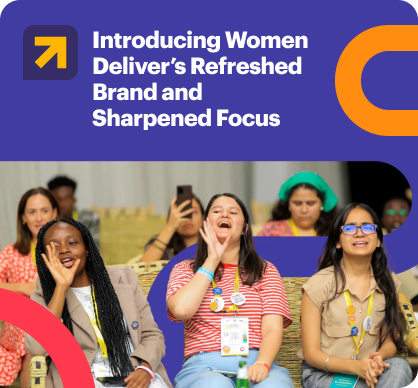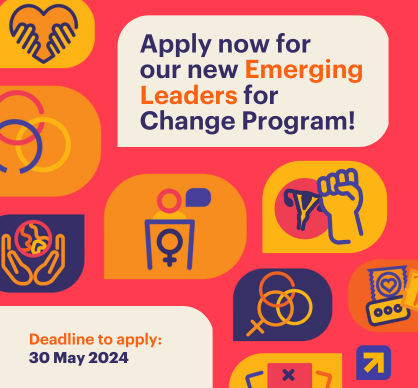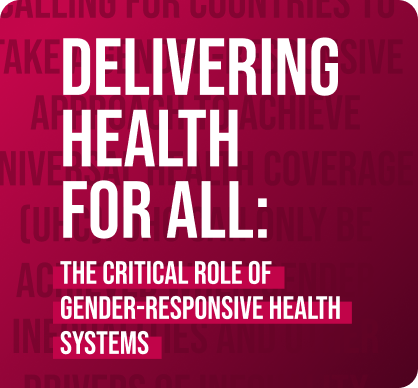 Produced by Women Deliver
May 8, 2016
Sharon D'Agostino, Saundra Pelletier, and Katja Iversen
Originally Published at Devex
Produced by Women Deliver
May 8, 2016
Sharon D'Agostino, Saundra Pelletier, and Katja Iversen
Originally Published at Devex
No individual, organization or sector can solve major global health and development challenges alone. But how we can work together to improve the health, rights and well-being of women and girls everywhere?
That question was at the center of a recent conversation between Women Deliver CEO Katja Iversen, Woman Care Global CEO Saundra Pelletier and Sharon D’Agostino, vice president of corporate citizenship at Johnson & Johnson.
J&J and Woman Care Global are both members of C Exchange, a corporate forum where businesses with an established track record in improving the lives of girls and women come together to share ideas and affect change.
Here’s an edited transcript of the conversation as provided by Women Deliver.
Iversen: Let’s get right to the question of the hour. What are the essential ingredients to ensure that organizations from different sectors can work together to improve health?
D’Agostino: As we work together to improve the health of girls and women, the first essential ingredient in successful collaborations is a shared commitment, and the second critical ingredient is trust. A wide range of stakeholders have important and distinct roles to play as we pursue a goal of healthier communities where girls, women and families thrive. So it is critical to begin every partnership or collaboration with an in-depth discussion about goals, roles and responsibilities. We have also learned that a detailed governance plan is important, as are specific accountability measures and indicators to gauge our collective impact. We must be willing to learn along the way, and adapt our plans when needed. Finally, it is important to have an exit strategy to which all parties agree, just in case the partnership fails.
Pelletier: Multisector collaboration is crucial to the success of Women Care Global’s business, which is focused on providing access to reproductive health solutions for girls and women around the world. All players in these partnerships have to self-assess and make sure there is some alignment in purpose or ability — ideally both. Whether we’re partnering with other nonprofits or with private sector companies, we must focus on the planning phase and we must use good business practices. I also think that we must be willing to stumble. The path to success is often full of failures, as well as the anger, frustration, and sadness that come with it. Recognizing our weaknesses is critical to getting the job done and to finding the right partner. We seek out organizations that fill a critical need and then we learn everything we can from them.
Iversen: Agreed! When we work together and advocate strategically, we generate tremendous potential to make progress around maternal, sexual and reproductive health and rights. I think that another trick to successful collaboration is to make a shared commitment to honest, open, and direct dialogue about how you can help not just one another, but the greater good. I also know that some dialogues are difficult and that the path to success is not easy. What are some of the most substantial barriers to success you’ve faced in multisector efforts to improve health? How did you overcome those barriers?
D’Agostino: Partnerships are both exhilarating and exhausting. Some of the most significant barriers in forming multisector collaborations include differing expectations of how success will be measured, differences in organizational cultures, and the speed at which decisions are made. We can overcome these barriers by developing a robust governance process for the partnership and ensuring that we have agreed upon impact assessments and accountability mechanisms in place. We have learned that it takes substantial time and energy to make multisector collaborations work. The net benefit is well worth the investment required to ensure success, and we have to make sure we adequately forecast the human and financial resources required.

Pelletier: I have found there can sometimes be a language barrier in partnerships. Different organizational tendencies and methodologies can sometimes lead to unmet expectations and strained relationships. We must be diligent and rigorous in finding the right partners and we must maintain that level of attention during the course of the alliance by establishing the parameters of collaborations and analyzing what’s working and what’s not working. Finally, it is okay to acknowledge that not everyone is meant to work together and it’s so helpful to share the lessons of those less successful ventures.
Iversen: As collaborations between different sectors — governments, nongovernmental organizations, the United Nations, the private sector, etc. — increase, we still hear of distrust and public skepticism that the private sector only caters to the rich and middle class in developing countries. Would you agree? What role can the private sector play in reaching the most vulnerable girls and women to ensure their health needs are met?
Pelletier: Yes, negative public perceptions of the private sector persist and we must abandon over-simplified caricatures that frame all for-profits as selfish and soulless. We need to increase awareness of what businesses can do, and in many cases are doing, beyond writing a check. Businesses have the capital and the reach to significantly impact the lives of the most vulnerable girls and women. They can galvanize support and resources. If you combine that with an NGO’s extensive contacts and regulatory knowledge you provide both organizations with the opportunity to really deliver on a mission.
D’Agostino: The private sector is as diverse as are governments, NGOs, or any global group of organizations. Delivery of improved health outcomes is the best measure of any organization’s commitment to the most vulnerable girls, women and families. Take for example when we work with partners to train skilled birth attendants, or to prevent and treat obstetric fistula. Then we are focusing where need is great. When all sectors work together, with mutual respect, we can change the world for girls, women, families, communities and nations.
Iversen: The World Economic Forum recently released the ninth edition of the Global Gender Gap Index, which captures the magnitude of gender disparity globally along a range of economic, political, educational and health-based criteria. The report showed that while some progress has been made, we still have a ways to go until gender equality is a reality for all. How do we jointly make sure that gender equality is a parameter in health for all?
Pelletier: We should never forget the Women Deliver motto that when we invest in girls and women, everyone wins. The WEF report you sighted reinforces a growing mound of evidence showing that businesses with gender equity in higher echelons of management have better profit margins. Gender equity needs to be a consideration in all of our efforts to address issues like climate change, sustainability, access and economic growth. Societal problems tend to have a disproportionately negative effect on girls and women. So, it is our shared responsibility to ensure that gender equality is a part of the post-2015 development agenda. In fact, it must be a part of every discussion about health and well-being. Through discussion and research, we figure out the remaining barriers between women and healthy lives. Then we stop discussing and we eliminate those barriers.
D’Agostino: Gender equality and access to health care are an integral part of our corporate responsibility and our business. In 2010, J&J was among the first private-sector companies to answer the U.N. secretary-general’s call to redouble the effort toward achieving the Millennium Development Goals — specifically those impacting maternal and child health. Our company pledged to support the three health-related MDGs with a comprehensive five-year commitment to reach as many as 120 million women and children a year by 2015. This pledge reflects a shared vision of a world in which women are healthy and children live to reach their full potential. Since then, the company has worked with dozens of partners to reach millions of women and children through its commitment to the MDGs. The focus on these vital issues will continue through 2015 and beyond.
Iversen: Sharon, Saundra, thank you. You have etched out the key components of a strong framework for multisector collaborations to improve health, the lives of girls and women, business, and society — no small feat. Your time and insights are appreciated and powerful as ever. Onward, together.


